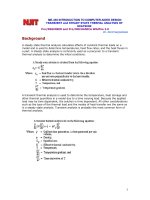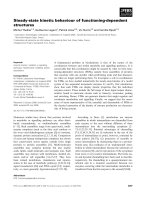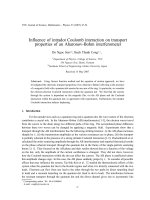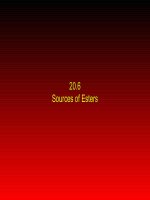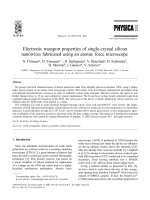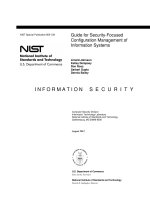Steady state transport properties of anharmonic systems
Bạn đang xem bản rút gọn của tài liệu. Xem và tải ngay bản đầy đủ của tài liệu tại đây (731.29 KB, 169 trang )
STEADY-STATE TRANSPORT
PROPERTIES OF ANHARMONIC
SYSTEMS
JUZAR THINGNA
NATIONAL UNIVERSITY OF SINGAPORE
2013
STEADY-STATE TRANSPORT
PROPERTIES OF ANHARMONIC
SYSTEMS
JUZAR THINGNA
M. Sc., University of Pune, India
A THESIS SUBMITTED
FOR THE DEGREE OF DOCTOR OF PHILOSOPHY
DEPARTMENT OF PHYSICS
NATIONAL UNIVERSITY OF SINGAPORE
2013
c
⃝ 2013
JUZAR THINGNA
ALL RIGHTS RESERVED
Declaration
I hereby declare that this thesis is my original work and it
has been written by me in its entirety. I have duly acknowledged all the sources of information which have been used in
this thesis.
This thesis has also not been submitted for any degree in any
university previously.
Juzar Thingna
4 May 2013
Acknowledgments
It is a pleasure to thank the few special people who have made this
thesis possible with their constant support and guidance.
First of all I would like to thank my dad, who has been my pillar of
strength throughout my graduate years. His immense patience and calm
pieces of advice have made this thesis possible and no words can truly
express how indebted I’m to him.
I am indebted to my supervisor, Prof. Jian-Sheng Wang, for his timely
guidance throughout my research. His immense experience and deep knowledge have guided me through several road-blocks during my research. I
would like to sincerely thank him for his “Yoda” like patience and tolerance with me during our umpteen discussions.
I’m immensely grateful to all my friends Amna, Nadiah, Mariam, Carolina, Nakul, Saran, Nithya, Arch‘a’na, Shelly, and especially Bani who have
been my greatest support system in Singapore. Without them I would have
probably not reached this far.
I’m grateful to several colleagues and collaborators, especially Dahai He,
Jose Garc and Prof. Peter Hănggi for their constant support and deep
ıa
a
thought provoking questions.
I would like to express my gratitude towards all the technical and nontechnical staff at the Department of Physics and the Center for Computational Science and Engineering, without whom it would have been impossible to concentrate on my research.
Last but not the least I would like to thank and dedicate this thesis to
my mom without whom I would not be what I am today.
i
THIS PAGE IS INTENTIONALLY LEFT BLANK
Contents
Acknowledgments
i
List of Publications
ix
List of Tables
x
List of Figures
xi
List of Symbols and Abbreviations
xiii
Chapter 1
Introduction
1
Chapter 2
Reduced density matrix formulation
9
2.1 Redfield master equation . . . . . . . . . . . . . . . . . . . .
10
2.1.1
Derivation from a microscopic model . . . . . . . . .
10
2.1.2
Further assumptions and limitations . . . . . . . . .
17
2.2 Accuracy of perturbative master equations in the steady-state 18
iii
2.3 Second order steady-state density matrix . . . . . . . . . . .
22
2.3.1
Dyson expansion for open quantum systems . . . . .
22
2.3.2
Analytic continuation approach: Modified Redfield
Solution . . . . . . . . . . . . . . . . . . . . . . . . .
26
2.4 Verifying the Modified Redfield Solution . . . . . . . . . . .
32
2.4.1
Comparison with canonical perturbation theory . . .
32
2.4.2
Numerical verification . . . . . . . . . . . . . . . . .
37
2.5 Summary . . . . . . . . . . . . . . . . . . . . . . . . . . . .
42
Chapter 3
Thermal transport
45
3.1 Master equation like formulation
. . . . . . . . . . . . . . .
46
3.1.1
Second order perturbation theory . . . . . . . . . . .
46
3.1.2
Few simple applications . . . . . . . . . . . . . . . .
56
3.2 Quantum self-consistent mean field approximation . . . . . .
67
3.2.1
Theory . . . . . . . . . . . . . . . . . . . . . . . . . .
68
3.2.2
Corroborating the QSCMF approach . . . . . . . . .
74
3.3 Summary . . . . . . . . . . . . . . . . . . . . . . . . . . . .
79
Chapter 4
Spin transport
83
4.1 Magnetic insulators . . . . . . . . . . . . . . . . . . . . . . .
84
4.1.1
Model and spin current . . . . . . . . . . . . . . . . .
84
4.1.2
Spin rectification . . . . . . . . . . . . . . . . . . . .
88
iv
4.2 Semiconductors . . . . . . . . . . . . . . . . . . . . . . . . .
96
4.2.1
Spin drift diffusion equations . . . . . . . . . . . . . .
96
4.2.2
Geometrical effects on spin injection . . . . . . . . . 101
4.3 Summary . . . . . . . . . . . . . . . . . . . . . . . . . . . . 108
Chapter 5
Conclusions and Future Work
111
Bibliography
122
Appendix A
Bath correlators and transition rates
133
A.1 Bath correlator . . . . . . . . . . . . . . . . . . . . . . . . . 133
A.2 Transition rates via Plemelj . . . . . . . . . . . . . . . . . . 135
A.3 Thermal bath models . . . . . . . . . . . . . . . . . . . . . . 136
A.3.1 Rubin Bath . . . . . . . . . . . . . . . . . . . . . . . 137
A.3.2 Ohmic bath with exponential cut-off . . . . . . . . . 138
A.3.3 Lorentz-Drude Bath . . . . . . . . . . . . . . . . . . 139
A.4 Richardson extrapolation . . . . . . . . . . . . . . . . . . . . 141
Appendix B
Canonical Perturbation Theory
145
B.1 Off-diagonal elements of the matrix D . . . . . . . . . . . . 147
B.2 Diagonal elements of the matrix D . . . . . . . . . . . . . . 148
v
Summary
The study of transport, in anharmonic systems, has been one of the
most challenging and fascinating field of theoretical physics in recent years.
Due to the dissipative nature of the bath and the fact that anharmonic
systems seldom have exact solutions, one employs approximations to describe the system in different parameter regimes. In this thesis, we look
at different approaches to describe anharmonic systems in a nonequilibrium steady-state condition. We first focus on the reduced density matrix
(RDM) of the system and use open-quantum system techniques, employing
the Redfield quantum master equation (RQME), to describe an anharmonic
system weakly connected to multiple heat baths. Unfortunately the steadystate solution from all second-order master equations, including RQME, is
incorrect at the second-order of system-bath coupling. Hence, to overcome
this difficulty a novel scheme based on analytic continuation to modify the
Redfield solution is proposed. The modified Redfield solution (MRS) is validated using canonical perturbation theory and the solution stemming from
the exact nonequilibrium Green’s function (NEGF) technique.
In the next part, we focus on the field of phononics and develop two
sui generis formulations to calculate heat current in anharmonic molecular
vi
junctions. The first approach, inspired by the quantum master equation formulation, calculates the steady state and transient heat current in strongly
anharmonic systems weakly coupled to heat baths. The theory is then
simplified for short-time transients and steady-state, where numerical validation for harmonic systems is provided. Anharmonic molecular junctions
like the FPU-β, ϕ4 and Duffing oscillator models are studied. The FPU-β
and ϕ4 models show peculiar low temperature behavior, which depends on
the translational invariance of the anharmonic potential; whereas the Duffing oscillator model shows negative differential thermal conductance, which
is essential to build phononic devices. Next, we overcome the weak systembath coupling approximation using NEGF techniques. The so-called quantum self-consistent mean field (QSCMF) approach treats the anharmonicity
perturbatively, but captures strong anharmonic effects in molecular junctions due to the self-consistent procedure. The QSCMF approach is corroborated with the master equation like formulation, perturbative NEGF
and quantum molecular dynamics.
In the last part of this thesis, we look at the field of spintronics, where
the main quantity of interest is the transport of spins. First we study
spin transport in an insulator modeled by an anisotropic Heisenberg spin
chain connected to thermal heat baths using the MRS. In this system, spin
rectification is investigated in detail and its dependence on several system
parameters is discussed. In particular it is shown that the rectification ratio
can be tuned with the help of the external magnetic field, which could be of
potential technological interest to build spin-diodes. From a technological
standpoint, understanding semiconductor systems on the nano- or micrometer scale is essential to build spintronic devices. In order to deal with such
vii
large anharmonic systems a semi-classical approach based on drift-diffusion
equation is adopted. The three-dimensional spin drift diffusion (3D-SDD)
equations are then applied to study the influence of device geometries on the
spin-injection ratio and several tricks to enhance the ratio are proposed.
viii
List of Publications
J. Thingna, J.-S. Wang, and P. Hănggi, Generalized Gibbs state with
a
modified Redfield solution: Exact agreement up to second order,” J.
Chem. Phys. 136, 194110 (2012).
J. Thingna, J. L. Garc´
ıa-Palacios, and J.-S. Wang, “Steady-state thermal
transport in anharmonic systems: Application to molecular junctions,”
Phys. Rev. B 85, 195452 (2012).
D. He, J. Thingna, J.-S. Wang, and B. Li, “Quantum thermal conduction
through anharmonic nano-junctions: A self-consistent phonon approach,”
(in preparation).
L. Zhang, J. Thingna, D. He, J.-S. Wang, and B. Li, “Nonlinearity enhanced interfacial thermal conductance and rectication, (submitting).
J. Thingna, J.-S. Wang, and P. Hănggi, Spin rectification in thermally
a
driven one-dimensional XXZ spin chains,” (in preparation).
J. Thingna and J.-S. Wang, “Geometric effects on spin injection: 3D spin
drift diffusion model,” J. Appl. Phys. 109, 124303 (2011).
J.-S. Wang, B. K. Agarwalla, H. Li, and J. Thingna, “Nonequilibrium
Green’s function method for quantum thermal transport,”
e-print arXiv:1303.7317v1 (submitting).
ix
List of Tables
3.1 Table of first three eigenvalues and corresponding populations for one particle and two particle Duffing oscillator system. . . . . . . . . . . . . . . . . . . . . . . . . . . . . . . .
x
66
List of Figures
1.1 An artists perception of a minimal transport setup. . . . . .
3
2.1 Discrepancy error for the ground state population as a function of system-bath coupling strength for a harmonic oscillator connected to two heat baths. . . . . . . . . . . . . . . .
40
2.2 Histogram of Populations comparing the MRS with Lindblad and RQME for a harmonic oscillator connected to one
and two heat baths. . . . . . . . . . . . . . . . . . . . . . . .
41
3.1 Graph of comparison between master equation like formulation and the exact NEGF result for one and two particle
harmonic oscillator systems. . . . . . . . . . . . . . . . . . .
58
3.2 Graph of conductance for one and two particle FPU-β, ϕ4
and FPU-β + ϕ4 models. . . . . . . . . . . . . . . . . . . . .
61
3.3 Graph of conductance for one and two particle Duffing oscillator model. . . . . . . . . . . . . . . . . . . . . . . . . . .
64
3.4 Graph of comparison between QSCMF and master equation
like formulation for one and two particles ϕ4 and FPU-β +
ϕ4 models. . . . . . . . . . . . . . . . . . . . . . . . . . . . .
75
3.5 Graph of comparison between QSCMF, perturbative NEGF,
and QMD formulations for ϕ4 and FPU-β + ϕ4 models. . . .
77
4.1 Graph of spin rectification vs system size and temperature
difference for a magnetic insulator. . . . . . . . . . . . . . .
91
4.2 Graph of forward-, backward current and rectification vs
magnetic field strength for a magnetic insulator. . . . . . . .
94
xi
4.3 Graph of spin injection ratio vs contact area and semiconductor height for a direct contact NiFe-nGaAs device. . . . . 103
4.4 Graph of spin injection ratio vs contact area for a NiFenGaAs device with AlO tunneling barrier and thin Cu film
insertion. . . . . . . . . . . . . . . . . . . . . . . . . . . . . . 104
4.5 Graph of spin injection ratio vs pinhole coverage area for a
single pinhole in AlO tunneling barrier. . . . . . . . . . . . . 106
xii
List of Symbols and
Abbreviations
List of Symbols
Htot Total Hamiltonian of the system + bath + system-bath
coupling.
HS
System Hamiltonian.
HB
Bath Hamiltonian.
HSB
System-bath coupling Hamiltonian.
HRN
Renormalization Hamiltonian.
α Bath label for multiple baths.
p Momentum of the particle.
x Conjugate position of the particle.
S
System operator coupling to the bath.
B
Bath operator coupling to the system.
λ Dimensionless parameter to keep track of the system-bath
coupling strength.
ρtot
Density matrix corresponding to the total Hamiltonian.
U(t0 , t) Evolution operator from initial time t0 to final time t corresponding to the total Hamiltonian.
H0
System + Bath Hamiltonian.
U0 (t0 , t) Evolution operator from initial time t0 to final time t corresponding to the system + bath Hamiltonian.
xiii
UI (t0 , t) Evolution operator from initial time t0 to final time t in the
interaction picture.
X nm
Hubbard operator in the system Hilbert space.
ρ Reduced density matrix of the system.
R Relaxation operator.
C(τ ) Bath correlator.
J(ω) Spectral density.
β
∆ij
Inverse temperature.
Energy difference between the system eigenvalues Ei and
Ej .
W
Transition rates.
˜
W′
Real part of the transition rates.
˜
W ′′
Imaginary part of the transition rates.
γ0
Damping kernel at time t = 0.
ρ(0)
Zeroth order reduced density matrix of the system.
ρ(2)
Second order reduced density matrix of the system.
V′
Real part of the derivative of transition rate with respect
to energy difference ∆.
V ′′
Imaginary part of the derivative of transition rate with respect to energy difference ∆.
M Mass of the system particle.
ω0
Harmonic frequency.
IL
Heat current flowing out of the left lead.
kl
gnm (u; t) Freely evolving Green’s function from time u to time t.
I
Current operator.
χ(τ ) Negative derivative of the bath correlator.
σ
Thermal conductance.
xiv
Ω Inter-particle harmonic frequency.
λ0
Strength of the on-site quartic potential.
λ Strength of the inter-particle quartic potential.
K
Tijkl
Spring-constant matrix.
General four tensor containing strengths of quartic potential.
G(1, 2, · · · , n) n-point correlation function.
TC
Contour-order operator on the Keldysh contour.
Σ Self-energy of the baths.
ΣRN
Renormalization Self-energy due to renormalization Hamiltonian.
VSα
Matrix containing information about system bath (α) coupling.
Gr
Retarded Green’s function.
Ga
Advanced Green’s function.
G<
Lesser Green’s function.
G>
Greater Green’s function.
T
nL,R
Transmission function.
Bose-Einstein distribution for left and right baths.
Γ Imaginary part of self-energy of the baths.
j
Local spin-current operator for magnetic insulators.
jS
Spin current flowing through the magnetic insulator.
R Spin rectification ratio.
j↑,↓
Spin-up and spin-down current flowing through the semiconductor.
µ↑,↓
Electrochemical potential for the spin-up and spin-down
channels.
xv
σ↑,↓
D
Spin dependent electrical conductivity for the up and down
channel.
Spin diffusion constant.
τ
Spin relaxation time.
P
Spin-injection ratio.
List of Abbreviations
RDM Reduced density matrix (of the system).
RQME Redfield quantum master equation.
MRS Modified Redfield solution.
CPT Canonical perturbation theory.
NEGF Nonequilibrium Green’s function.
DE Discrepancy error.
QSCMF Quantum self-consistent mean field.
NDTC Negative differential thermal conductance.
QMD Quantum molecular dynamics.
SDD Spin drift diffusion.
FM Ferromagnet.
SC Semiconductor.
xvi
Chapter
1
Introduction
The most exciting phrase to
hear in science, the one that
heralds new discoveries, is not
“Eureka!” (“I found it!”) but
rather “hmm....that’s funny...”.
Isaac Asimov
The study of transport through nano and molecular junctions has been
one of the most intriguing and challenging tasks of condensed matter physics
for the past 50-60 years. Typical experimental transport setups involve a
system of interest connected to two or more macroscopic baths, which are
maintained at different temperatures, chemical potentials, etc., injecting
and removing the carriers of transport from the system as illustrated in
Fig. 1.1. The system is generally well characterized due to its finite size,
whereas the baths are largely unknown. Such archetypal experimental setups have inspired a plethora of transport theories which eliminate the baths
and focus on the system and its properties. The cumulation includes: the
1
CHAPTER 1. INTRODUCTION
Kubo formula [1, 2] which is rigorously valid only in the thermodynamic
limit; an offshoot of the scattering theory known as Landauer-Buttiker formalism [3, 4, 5, 6] which is valid as long as the carriers are coherent; the
nonequilibrium Green’s function method [7, 8] which is best suited for harmonic systems, but can treat anharmonicity in a perturbative manner; the
quantum master equation approach [9, 10, 11, 12, 13] which is valid under a weak system-bath coupling approximation and can deal with only
small system sizes; the Boltzmann transport equations [14, 15, 16] which
are used to study linear response heat transport and typically require the
anharmonicity to be treated perturbatively; the hierarchy equation of motion approach [17, 18, 19] which is valid only for Ornstein-Uhlenbeck type
of processes and can be solved for extremely small system sizes only; molecular dynamics [20, 21] which is typically employed in the study of thermal
transport and is valid only in the high-temperature classical regime and
quantum Monte Carlo [22, 23, 24] simulation which require a perturbation
either in the anharmonicity or the coupling strength and is best suited only
to study transient transport.
Exact treatment of anharmonic systems has been one of the holy grails
of such transport theories and some of the most exciting effects like rectification, negative differential resistance, thermoelectric effect, thermomagnetic
effect, etc. are due to anharmonicity. Inspired by these novel effects we will
2
CHAPTER 1. INTRODUCTION
focus on theories that can deal with strongly anharmonic systems and explore some of these effects in heat and spin transport. Our primary approach
to treat strong anharmonicity rigorously will be the quantum master equation formulation, but we will also look at methods which try to overcome
the limitations of the master equation formulation,i.e., weak system-bath
coupling and small system sizes.
Figure 1.1: An artists perception of a minimal setup required for transport.
The baths are depicted by the orange enclosed areas, whereas the system
is the lime-green rectangular box in the center. The carriers of transport
are depicted by the red spherical objects moving through the system due
to high abundance in the left bath as compared to the right.
In this thesis, chapter 2 will be dedicated to the introduction and development of quantum master equation (QME) formalism. Several formally
exact master equations either within a time-convolution (time-non-local)
[25, 26] or time-convolutionless (time-local) [27, 28, 29, 30, 31, 32] form
can be found in the literature, but all these approaches are computationally very demanding and can treat systems possessing an extremely small
3
CHAPTER 1. INTRODUCTION
Hilbert space dimension only, i.e., 2-4 levels maximum. Our main goal in
this chapter will be to accurately calculate the reduced density matrix for
relatively large Hilbert space dimensions and treat the underlying anharmonicity exactly. In order to do this we will first introduce some of the
techniques of open quantum systems with the introduction of the generic
Redfield quantum master equation (RQME). We will then show that the
RQME is inaccurate in the steady state and hence propose a modified Redfied solution (MRS) which captures the steady state reduced density matrix
correct up to second order in the system-bath coupling. Besides being accurate the MRS will allow us to handle large system Hilbert spaces up to
210 levels, which is a huge improvement over the 2-4 levels used in the literature. Thus using the MRS we will be able to accurately evaluate any local
quantity of interest, including currents, for relatively large Hilbert space
dimensions in the nonequilibrium steady state condition.
In chapter 3 away from the predominant field of electronic transport
we will cover the field of heat transport commonly known as phononics.
The earliest works in this field date back to Debye and Peierls [33, 34]
who studied heat transfer within solids. Inspired by their work most of
the research in this field is concentrated on the classical heat transport either in the form of theoretical considerations [20, 35, 36, 37, 38, 39, 40, 41]
or using simulation techniques like molecular dynamics [21]. Even though
4
CHAPTER 1. INTRODUCTION
these techniques give us good insight at the classical properties they can
not be applied at low temperatures, where quantum effects become essential and hence techniques like the nonequilibrium Green’s function (NEGF)
[42, 43, 44, 45, 46, 47], quantum molecular dynamics [48], and master equation formulation [9, 10, 11, 12, 13] have been developed to tackle the lowtemperature regime accurately.
Our main focus in this chapter will be on two most popular techniques
to deal with quantum anharmonic heat transport namely the master equation formulation and the nonequilibrium Green’s function (NEGF) method.
Since all systems do not permit a unique local heat current operator definition we develop a master equation like formulation inspired by the fundamental definition of heat current, i.e., change in energy of the heat bath.
The formulation suffers from the weak system-bath coupling limitation and
hence to explore the strong-coupling regime we develop a self-consistent formulation using NEGF techniques. The so-obtained quantum self-consistent
mean field (QSCMF) approach will not only allow us to explore the strong
system-bath coupling regime but also the strong anharmonic regime.
Next we look at spin transport in chapter 4, which has been one of the
most promising field of the past two decades. The explosive interest in the
field started with a spin-interference device proposed by Datta and Das
[49] in 1990 and has led to a vibrant and exciting new field of spintronics1
1
The term was coined by S. A. Wolf in 1996, as a name for a DARPA initiative for
5


